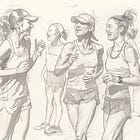5 Stories to Take Your Mind Off the Election
What's making me happy: disconnected walking, dancing tortoises, functional fashion, and more.
I had a story lined to share today, but then thought, “Nope. Save it until after the election.” If you’re like me, you’re in a state of high political distraction; we could both use a reprieve.
So take a break from fretting about what a few thousand Pennsylvanians decide to do tomorrow. Here are five things I loved this month:
1. “The Dancing Tortoise” by
Sometimes you come across an essay that sticks the landing. And this one hits with joy.
Katz, an incisive commentator on the Millennial productivity complex, asks how the fable “The Tortoise and the Hare” stands up in our frenetic moment:
The story should actually be told this way to my kids entering the current cultural context: three hares challenged each other to a race. The first hare thought he might be able to win and trained really hard (sucker!). The second hare posted boldly on social media, “I will win!” The third hare created an online course on how to be the ultimate winner in just one week of training, taught by a hare who has done it himself. The winner, of course, was the third: the loudest, most confident hare. The turtle, meanwhile, was smoking weed in his parents’ basement.
The race framework is itself the problem. As my friend Crosby Freeman likes to quip, “Slow and steady wins the race … except in an actual race.” And racing defines most modes of life these days: school, work, politics, even leisure.
So Katz explodes the whole concept.
Read it here

2. “The Walking Rebellion: Restoring the Mind at Three Miles an Hour” from
A thoughtful assembly of research, writing, and philosophy that points to walking as a means of escaping the algorithmic hellscape that dominates our minds.
One theory posits that walking promotes a fractal spontaneity within the mind, neural activity that follows branching patterns throughout the brain. Spending too much time behind a screen makes our thoughts staccato and disjointed; yet once we start walking, our mind begins to smooth, slow, and explore.
Read it now
3. “Hans Zimmer’s Remote Control” from Twenty Thousand Hertz
Decades ago in high school, I often sat on a schoolbus loaded with the track or cross-country team as we headed to race at some far-flung school carved from former cotton fields in the rolling Carolina hills of Rowan and Cabarrus counties.
As the bus bumped along the country roads, I’d listen to a burned CD of pump-up music, which included the The Battle track from Hans Zimmer’s Gladiator score. Trumpets and trombones raced along with the Roman cavalry as they cut through the Germanic horde, and I’d sit on the pleather seat, quietly amping up to run as hard as I could.
Last month, a quarter-century later, I got a chance to hear that piece again at the Oakland Arena where Zimmer performed his greatest movie hits live with a full orchestral suite. The music was stunning, the performers entertaining, the lighting and sound design face-melting.
Also fun were the stories Zimmer told between pieces. During one interlude, he described working with director Ridley Scott on Gladiator:
“We’d worked this one piece for days, honing it, refining it, and we thought we had it in a good place. And we play for it Ridley and he goes, ‘No! It’s crap; that’s not right at all!’”
So the composer and director spent the next few hours discussing and workshopping the music, rethinking and reshaping to meet the needs and tone of the scene. “Failure is a conversation,” he noted in Oakland. “It opens up possibility and new direction.”
If you like that kind of thinking, you’ll love the podcast episode from Twenty Thousand Hertz that explores how Zimmer and his creative team create iconic film scores.
Listen here
4. from
I’m always stoked when The Sweat Lookbook hits my inbox. Glandorf examines the intersection of sport and style, and while you’ll never see me at the cutting edge of sportswear, I think there are interesting cultural inferences to be gleaned from fashion trends and design, especially when it relates to functional movement.
A few pieces I especially enjoyed:
5. Super-Infinite by Katherine Rundell
Hat tip to writer and nuclear policy research scholar Jane Darby for sharing the amazing Rundell with me. In this acrobatic biography of the poet John Donne, Rundell reviews Donne’s life in tumultuous Elizabethan England, but levels deeper focus on the poet’s electric writing.
Rundell’s own prose alternatively sparkles and slices. I’m in awe of this passage:
“It is necessary to shake language until it will express our own distinctive hesitations, peculiarities, our own variation and never-quite-successful yearning towards beauty. Donne saves his most ruthless scorn for those who chew other wits’ fruit, and shit out platitudes. Language, his poetry tells us, is a set, not of rules, but of possibilities.”
🤯
I can’t wait for a holiday work break when I’m going to read Rundell’s latest, Impossible Creatures.














Loved this, Sam. Not only the great curation, but your writing as well!
What an honor! Thanks for the inclusion and the support, Sam.